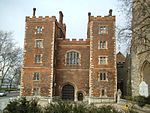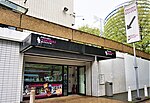Archbishop's Park
1901 establishments in EnglandHistory of the London Borough of LambethParks and open spaces in the London Borough of LambethUrban public parks in the United KingdomUse British English from January 2021

Archbishop's Park is a 3.93 hectares (9.7 acres) park in Lambeth in the London Borough of Lambeth in London, England, which opened to the public in 1901. Before it became a park, it formed part of the grounds of Lambeth Palace.
Excerpt from the Wikipedia article Archbishop's Park (License: CC BY-SA 3.0, Authors, Images).Archbishop's Park
Carlisle Lane, London Lambeth (London Borough of Lambeth)
Geographical coordinates (GPS) Address Nearby Places Show on map
Geographical coordinates (GPS)
| Latitude | Longitude |
|---|---|
| N 51.497 ° | E -0.116 ° |
Address
York House
Carlisle Lane
SE1 7LD London, Lambeth (London Borough of Lambeth)
England, United Kingdom
Open on Google Maps








